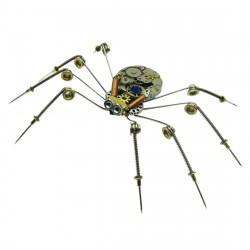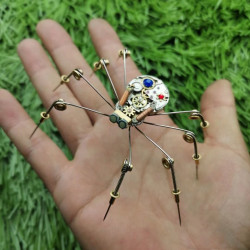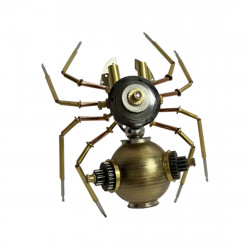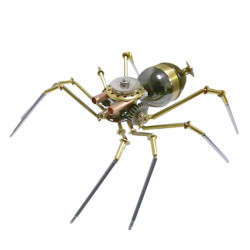Spider Lovers
Everything You Need to Know about Jumping Spiders
One kind of spider member of the Salticidae family is the jumping spider. The world's most prominent family of spiders, this group includes more than 6,000 distinct species. Their tendency to leap from place to place while hunting and their distinctly wide eyes make them easy to identify. Jumping spiders can be found in most environments, although they are most prevalent in tropical areas.
Jumping spiders are an exceptional kind of spiders, distinguished by their intricate courtship rituals and behaviors. They come in various colors and patterns and are typically tiny to medium-sized spiders. Although some species can grow up to two inches long, the typical jumping spider is only half an inch long.
The cephalothorax and the abdomen are distinct portions of a jumping spider's body. The spider's head, mouthparts, and eight legs are located in the cephalothorax. The spider's digestive tract, silk glands, and reproductive organs are located in the abdomen. Despite having eight eyes, jumping spiders only use their anterior median eyes (AME) to sense movement and potential food. These eyes are the biggest on the spider in front of the head.
Being energetic hunters, jumping spiders usually hunt during the day. They will leap or pounce on their prey after using their AME to detect movement. Their primary food source is small insects, but if larger prey is available, they will also eat it.
Apart from their adeptness in hunting, jumping spiders are renowned for their intricate courtship customs. Men would frequently put up shows and dances to entice women. To prove his worth as a mate, the male may give the female a gift, like a dead insect.
Because of their extreme adaptability, jumping spiders can live in various temperatures. They don't weave webs but use silk to build a haven where they can spend the day hiding from predators and resting.
In general, jumping spiders are not thought to be harmful to people. If they sense danger, they might bite, but this is usually not severe and will kill you somewhat. Because they aid in managing insect populations, jumping spiders are essential to many ecosystems, and their presence is frequently advantageous to humans.
Despite their millions of years of existence, our knowledge of jumping spiders is still somewhat restricted. More research is required to learn more about their behavior, ecology, and evolution.
People will be fascinated by jumping spiders for a long time since they are such amazing creatures. They offer valuable services like pest management and are integral to many ecosystems. Watching them engage in complex courtship rituals and foraging for food is also entertaining.
There is much to learn about jumping spiders, regardless of your interest in science or being a casual spider enthusiast. You will be amused and informed for years to come by jumping spiders because of their diverse range of colors, patterns, and actions.
Jumping spiders are crucial to our ecosystems because they help regulate insect populations. They are also unique animals to watch, and we can spend hours watching them because of their unusual mannerisms and complex courtship rituals.
Exciting information about jumping spiders
- Among all spiders, jumping spiders are the only ones that can jump up to 50 times their body length.
2. Unlike other spiders, jumping spiders have a more comprehensive range of vision and superior color vision.
3. Spiders that jump can measure their jump's distance precisely and modify their jump accordingly.
4. Before leaping, jumping spiders move forward in a zigzag motion with their legs.
5. Rather than spinning webs, jumping spiders hunt for their meal.
6. Jumping spiders have a maximum jump length of three feet and a maximum jump speed of 1.5 feet per second.
7. Jumping spiders can detect vibrations in the air with their front legs and keen sense of touch.
8. Up to three times their size of prey can be caught and consumed by jumping spiders.
Everyone should take the time to recognize and educate themselves about jumping spiders since they are a fantastic species. The intricate courtship rituals, distinctive hunting techniques, and striking colors and patterns of jumping spiders are likely to pique your interest.
Comparing Tarantula Spiders and Wolf Spiders: What's the Difference?
Many people frequently mistake tarantulas for wolf spiders when it comes to spiders. Despite their similar appearances, these animals are very different from one another and can even be found in various parts of the planet. Accurately identifying these two spiders can be aided by knowing their distinctions.
Tarantula spiders are more giant and robust and have longer hairs all over their body and legs than wolf spiders. They are typically found in environments with more flora, such as woods, deserts, and jungles, and they also have longer legs. Generally speaking, tarantula venom is not thought to be harmful to people. Giant, hairy spiders, known as tarantulas, are primarily found in tropical and subtropical regions of the world. They have long, robust legs ranging from 5 to 30 cm. They come in an extensive range of hues, such as pink, brown, and black. They hunt by ambushing their prey, and they are often nocturnal. Though not as deadly to humans as other spider species, tarantulas have long fangs and venomous bites.
However, wolf spiders are much smaller than tarantulas, with a range of sizes from 2 to 25 cm. Their abdomen features a distinctive striped pattern, and they are often brown in hue. Although wolf spiders lack venom since they lack fangs, they have powerful jaws that allow them to capture and consume their food. Since they hunt actively, they pursue their prey instead of ambushing it.
Tarantula spiders are more giant and robust and have longer fur all over their body and legs than wolf spiders. They are typically found in environments with more flora, such as woods, deserts, and jungles, and they also have longer legs. Generally speaking, tarantula venom is not thought to be harmful to people.
In contrast, wolf spiders are tiny and have short body hairs covering them. They are typically found in open areas such as fields and meadows, and humans may be at risk from their venom. Wolf spiders are more suited for hunting since they can move swiftly and have longer legs.
The vast, hairy bodies of tarantula spiders can be brown or black in hue. They have spinnerets at the end of their abdomens and eight eyes in two rows. Wolf spiders are usually dark brown or gray and have a distinct pattern of markings on their bodies. They have eight eyes arranged in three rows and lack the spinnerets at the end of their abdomens that tarantulas have.
Wolf Spider vs Tarantula is a battle between two of the arachnid world's most formidable predators. The Wolf Spider is a large, fast-moving hunter in many parts of the world. Its strong jaws make it easy to take down prey, and it has excellent vision. The Tarantula is a giant, slower-moving predator native to tropical and subtropical regions. Before consuming its meal, it paralyzes its victim with poison.
The Wolf Spider would likely come out on top in a fight between a Wolf Spider and a Tarantula. It is faster, more agile, and has superior eyesight. It can also use its powerful jaws to take down the Tarantula before it can strike. On the other hand, the Tarantula is slower and may not be able to get close enough to the Wolf Spider to deliver a deadly bite.
The wolf spider is more dangerous than the Tarantula, as it is more likely to bite if disturbed. Wolf spiders are also more aggressive and can deliver a more painful bite than the Tarantula.























